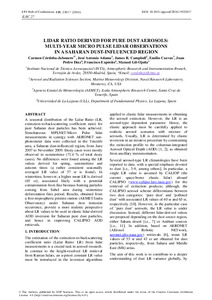Por favor, use este identificador para citar o enlazar este ítem:
http://hdl.handle.net/20.500.11765/7481
Lidar ratio derived for pure dust aerosols: multi-year micro pulse lidar observations in a Saharan dust-influenced region
Registro completo de metadatos
| Campo DC | Valor | Lengua/Idioma |
|---|---|---|
| dc.contributor.author | Córdoba-Jabonero, Carmen | es_ES |
| dc.contributor.author | Adame, José Antonio | es_ES |
| dc.contributor.author | Campbell, James R. | es_ES |
| dc.contributor.author | Cuevas Agulló, Emilio | es_ES |
| dc.contributor.author | Díaz González, Juan Pedro | es_ES |
| dc.contributor.author | Expósito González, Francisco Javier | es_ES |
| dc.contributor.author | Gil-Ojeda, Manuel | es_ES |
| dc.date.accessioned | 2017-08-17T08:15:55Z | - |
| dc.date.available | 2017-08-17T08:15:55Z | - |
| dc.date.issued | 2016 | - |
| dc.identifier.citation | EPJ Web of Conferences. 2016, 119 | es_ES |
| dc.identifier.issn | 2100-014X | - |
| dc.identifier.uri | http://hdl.handle.net/20.500.11765/7481 | - |
| dc.description | El volumen 119 de 2016 de la revista EPJ Web of Conferences recoge las ponencias del 27th International Laser Radar Conference (ILRC 27) | es_ES |
| dc.description.abstract | A seasonal distribution of the Lidar Ratio (LR, extinction-to-backscattering coefficient ratio) for pure Saharan dust particles has been achieved. Simultaneous MPLNET/Micro Pulse lidar measurements in synergy with AERONET sun-photometer data were collected in the Tenerife area, a Saharan dust-influenced region, from June 2007 to November 2009. Dusty cases were mostly observed in summertime (71.4 % of total dusty cases). No differences were found among the LR values derived for spring, summertime and autumn times (a rather consistent seasonally averaged LR value of 57 sr is found). In wintertime, however, a higher mean LR is derived (65 sr), associated likely with a potential contamination from fine biomass burning particles coming from Sahel area during wintertime deforestation fires period. Results, obtained from a free-tropospheric pristine station (AEMET/Izaña Observatory) under Saharan dust intrusion occurrence, provide a more realistic perspective about LR values to be used in elastic lidar-derived AOD inversion for Saharan pure dust particles, and hence in improving CALIPSO AOD retrievals. | es_ES |
| dc.description.sponsorship | This work has been supported by the Spanish Ministerio de Economía y Competitividad (MINECO) under grant CGL2011-24891 (AMISOC project). | es_ES |
| dc.language.iso | eng | es_ES |
| dc.publisher | EDP Sciences | es_ES |
| dc.rights | Licencia CC: Reconocimiento CC BY | es_ES |
| dc.subject | Lidar Ratio | es_ES |
| dc.subject | Dust particles | es_ES |
| dc.subject | Aerosols | es_ES |
| dc.subject | Sunphotometer | es_ES |
| dc.title | Lidar ratio derived for pure dust aerosols: multi-year micro pulse lidar observations in a Saharan dust-influenced region | es_ES |
| dc.type | info:eu-repo/semantics/article | es_ES |
| dc.relation.publisherversion | https://dx.doi.org/10.1051/epjconf/201611923017 | es_ES |
| dc.rights.accessRights | info:eu-repo/semantics/openAccess | es_ES |
| Colecciones: | Artículos científicos 2015-2018 | |
Ficheros en este ítem:
| Fichero | Descripción | Tamaño | Formato | ||
|---|---|---|---|---|---|
| epjconf_ilrc2016_2301... | 784,51 kB | Adobe PDF |  Visualizar/Abrir |
Los ítems de Arcimis están protegidos por una Licencia Creative Commons, salvo que se indique lo contrario.





